Some think of okra as the “Jolly Green Giant” of the garden because the lobe-leafed member of the mallow family (related to the hibiscus) can reach heights of six feet or more in areas with a long growing season. Thus, one might think this vegetable requires a traditional garden row in order to flourish. But okra can thrive in containers, as well!
The Key to Container Success
As with any plant, the key to successfully growing okra in containers is using quality soil. Okra appreciates soil that is rich in organic matter that drains well and has a pH between 6.0 and 7.0. The size of the container is also important. While you won’t need a gigantic one, the larger the pot, the more productive the plant. I’ve grown this gumbo staple with good results in pots ranging from 11″ to 14″ in diameter and 10″ to 12″ in depth.
Okra Varieties
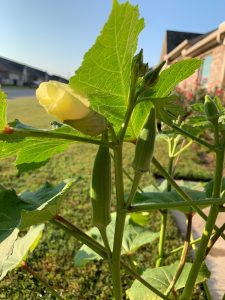
While there is some debate as to okra’s origin, most will agree it came from Africa, possibly Ethiopia.[1] In locations outside of the United States, this vegetable which is rich in calcium, iron, potassium, vitamin C, and fiber, may be referred to as “gumbo.” The term gumbo is believed to be a corruption of the word quillobo, which is the native name for the plant in the African nations of Congo and Angola.[2] Here in America, gumbo refers to the spicy rue-based soup that contains stewed okra.
By far, the most popular variety of okra is the Clemson Spineless, so named because it doesn’t have spines or bristles on its leaves and stems, as other varieties do. The large pale yellow blossoms with deep crimson centers, look strikingly like its “cousin” the hibiscus flower. This variety is ready to harvest in about 55-60 days.
Other popular varieties include the Annie Oakley II, which also has spineless pods and can be harvested in 48-52 days. The Burgundy Okra variety has deep red to purple pods and is ready in about 55 days. The Cajun Delight is popular with gardeners in colder climates with shorter growing seasons because it’s ready to be harvested in 50-55 days. Little Lucy has red pods and reaches a height of only 2′ tall and matures in 55 days, while the Louisiana Green Velvet reaches 6′ tall and matures in 65 days.
This article contains affiliate links. If you make a purchase using one of these links, I will receive a very small commission at no additional cost to you, and it will help me maintain this website. Rest assured, I only recommend products I actually like!
How to Plant Seeds
To plant okra from seed, you’ll need to soften the outer casing of the seeds by soaking them in warm water for at least an hour or, for better results, overnight in water that is room temperature. (The process is called seed scarification, and you can learn more about the three scarification methods to increase seed germination rates and speed in this helpful article.) The seeds that float to the top are not viable and should be discarded. Plant each seed between 1/2″ to 1″ deep with two or more seeds per container. Once they germinate and grow to about 2-3″ tall, choose the heartier seedling and cut the remainder off at soil level. If your container is 14″ or more in diameter and at least 10-12″ deep, you may be able to house two plants. I’ve done so with good results. Experiment and see what works best for you.
You can start seeds indoors under grow lights six to eight weeks before the last frost date. But the seedling’s taproot can be sensitive, so be careful when you transplant it. Alternatively, direct sow seeds outdoors when the evening temperature is consistently at 60°F or warmer and the daytime temperature is routinely 85°F. Plant in succession every two weeks until you reach the number of desired plants.
Light Requirements
Okra plants love the sun, so be sure they receive at least six hours, preferably more, of full sun.
Water Requirements
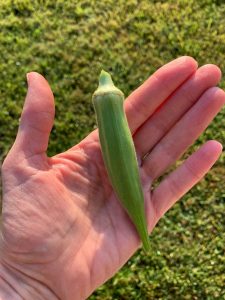
Even though okra are heat tolerant, be sure to keep the soil evenly moist. Because they’re in containers, the soil will dry out much quicker, especially in warm temperatures, than if they were planted in the ground. Water thoroughly in the morning but keep an eye on them during the day, especially in the hotter months. A little leaf droop in the afternoon is expected in warmer climates, but you may need to water them again if they droop too much. (Note: When you turn on the water hose, be sure to let the water cool down before applying to your plants. Warm or hot water from a hose that’s been sitting in the sun could damage the roots.)
Fertilizer
Plants in containers will lose nutrients from the soil quicker than plants in the ground because water draining out of the containers will carry the nutrients away. Okra plants are heavy feeders, so you’ll need to feed them regularly using an organic fertilizer. If your plants aren’t producing flowers, you may need to apply a fertilizer that is slightly higher in phosphorus than nitrogen. (Just be sure to follow the directions on the package.) Too much nitrogen can cause them to produce more foliage but fewer flowers and pods. However, in general, a balanced fertilizer (nitrogen, phosphorus and potassium in equal amounts) should be fine.
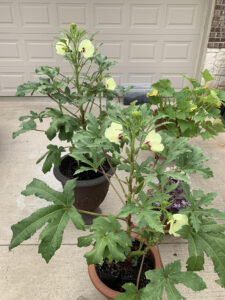
Harvest
Harvest the okra when they are between 2″ and 4″ long, otherwise they will be too tough and fibrous to eat. When you cut it from the stalk, leave a 1/4″ to 1/2′ piece of the stem attached to the okra. This will protect the inside of the okra until you’re ready to eat it. As with most vegetables, if you are not going to eat it right away, do not wash it because the residual moisture on the okra could promote mold growth. Simply place it in a partially closed baggie in the crisper drawer of your refrigerator where it should last 4-7 days. Wash before cooking.
Seed Collecting
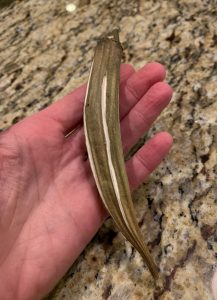
It’s easy to harvest the seeds from okra plants. Simply leave a few pods on the healthiest plant at the end of the growing season. Once the pods turn brown and dry out, they will develop a hard shell, and you’ll be able to hear the seeds rattle inside when shaken. It may take weeks for the pods to dry out, so be patient. Seeds, if stored properly in a cool, dry, dark place they should be viable for two to five years. (Here’s a chart on how long various seeds last in storage.)
Pests
Take a few minutes before you water in the morning to inspect your plants for insects. Look under the leaves, examine the stalk, and look at the soil. You’ll be amazed at the number of variety of bugs that are hiding in plain sight!
Some of the more common pests that afflict okra plants are aphids, stinkbugs, cabbage worms, flea beetles, Japanese beetles, corn earworms, root knot nematodes, whiteflies, and leaf miners.
Diseases
Fungi such as verticillium and fusarium (damping off) can cause okra plants to wilt and eventually die. The fungus can also spread to healthy plants, so it’s important to address the problem right away.
Another common disease that can affect okra plants is powdery mildew. This fungus causes powder-like spots to appear on leaves that may spread to cover the entire plant. If severe, the leaves may roll or curl upward and might also appear scorched.
Problem Solving
Lack of flowers -If your okra isn’t blooming and you find yourself singing, Where Have All the Flowers Gone? read this article 6 Reasons Your Okra Plant Doesn’t Have Flowers.
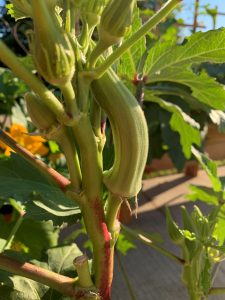
Flowers fall off before forming pods – This could be due to temperatures 95°F and above. Be sure to keep your plants well hydrated. On the other hand, if it’s late in the season and the temperatures are dropping, it could be the reasons the flowers are, too. Contact the county extension agent for the county you reside in. They’ll have a list of optimum dates for growing each vegetable. Here is a list of the agents if you live in the great state of Texas.
Flowers but no pods – Several things can contribute to your plant producing blooms but not pods. For example, too much nitrogen in the soil can promote foliage growth but not pod formation. If this is the case, try using a fertilizer with less nitrogen. Or your plant may not produce pods if the weather is too hot or if the plant is not receiving enough water. Both situations can stress the plant and cause pod production to be inhibited.
Deformed pods – Okra, also known as ladyfingers because of their finger shaped pods, are supposed to be straight as if pointing. But sometimes you’ll see curled or deformed pods. Though unsightly, the misshaped pods should still be edible. Find out the cause and the remedy in this article: What Causes Okra Pods to Curl?
I hope you’ll agree with me that okra is a fabulous vegetable to have growing in your garden. It tastes great and the flowers are beautiful! Grab a container and plant some in your garden!
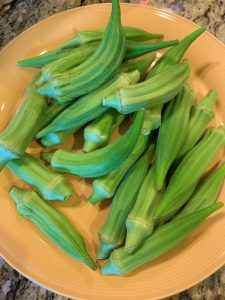
Note: If you found this article to be helpful, please share it with someone you think might be interested in it as well. Thank you!
[1] Miracle Gro Complete Guide to Vegetables, Fruits and Herbs, Denny Schrock, ed., (New Jersey: John Wiley & Sons, 2008), p. 80.
[2] “Okra or Gumbo From Africa,” Aggie Horticulture, Texas A&M Agrilife Extension, accessed 6-19-20, https://aggie-horticulture.tamu.edu/archives/parsons/publications/vegetabletravelers/okra.html
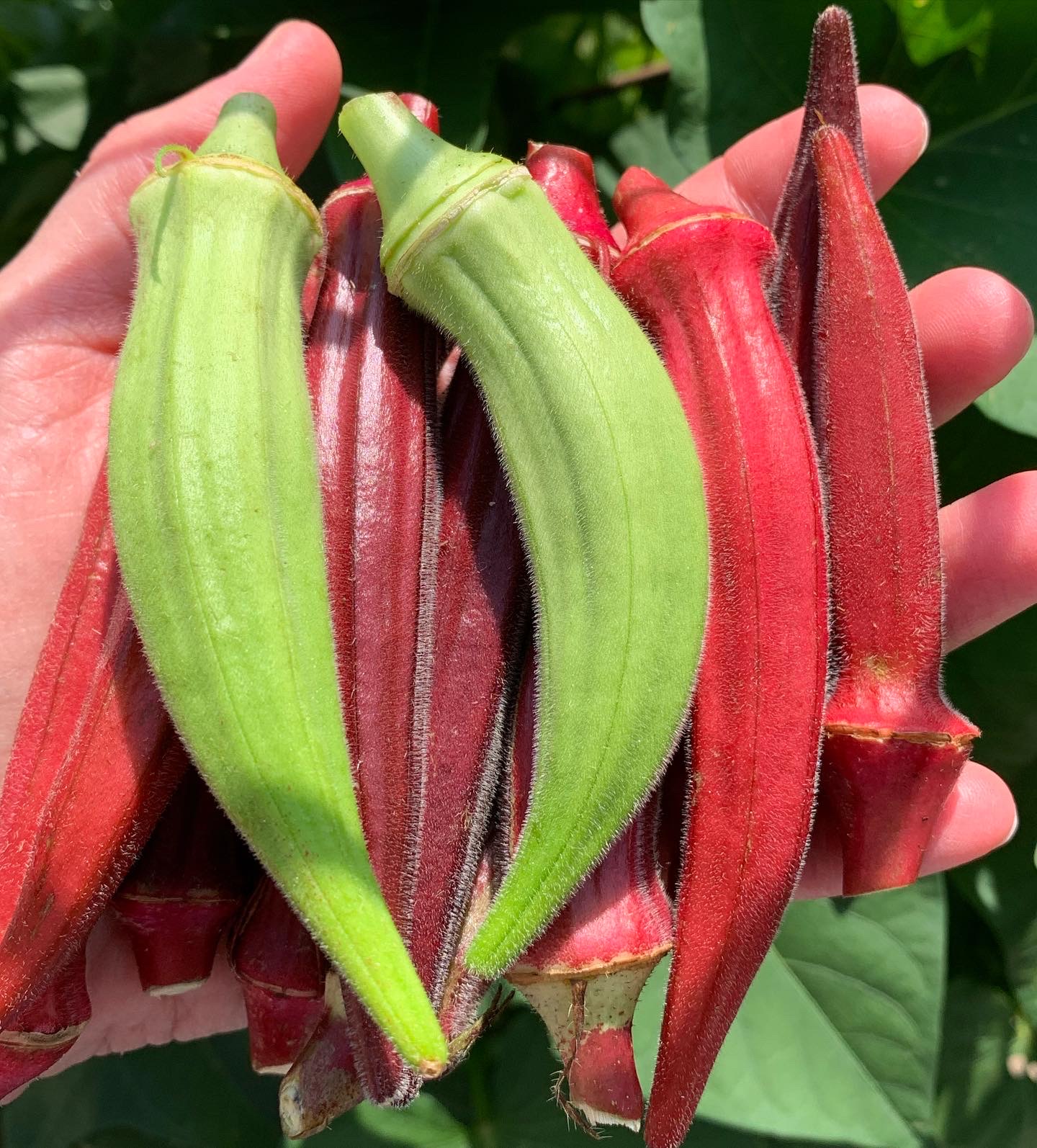
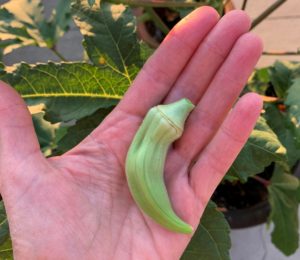
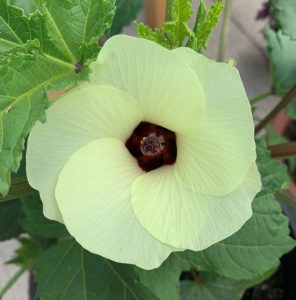

Would be nice if you showed the entire okra plant in the pot/container so we could see the size.
Hi! Thanks for your feedback. I had to dig through some older pictures, but I finally found one the entire plant in a container and posted it to the article. The plants can grow quite tall, even 10 to 12 feet. The plants in this picture are younger. You can top off the growing tip if you do not want them to get as tall. Hope this helps!